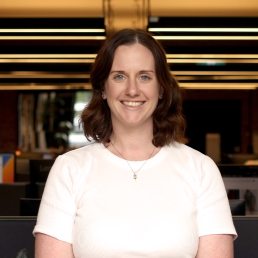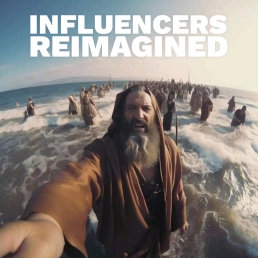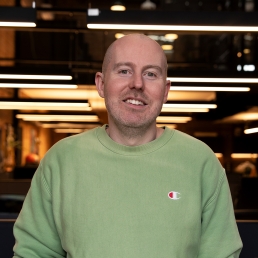Connecting Plots Expands Full-Service Offering With Launch of Digital & Media Capability
The new capability is spearheaded by Inez Zimakowski, who joins as Head of Digital & Media, bringing more than a decade of experience spanning in-house and agency roles across the fashion, automotive, and retail sectors, including Hyundai, Oroton and Edge.
This follows the agency’s recent expansion into PR and earned media with the appointment of Katie Eastment as Head of PR in April and complements the growth of the specialist social and influencer offering a.glo, headed up by Kent Pearson.
The agency’s integrated offering now delivers a seamless blend of creative, strategy, social, earned, production and media solutions all under one roof.
Our mission is to grow our clients’ businesses through truly connected brand experiences. Owned and paid channels are a critical piece of that puzzle. With Inez leading our digital and media capability, we’re now able to better shape end-to-end solutions that deliver business impact to our clients.
For the right types of clients, the full service offering we’re building will be the perfect fit. We’re proving that by smashing down the silos between strategy, creative and media who can build and then live optimise campaigns and creative to nail the objectives in a much more cost efficient way.
On the flip side, we’re doubling down on our collaborative partnerships with other media agencies – keeping media thinking as core to our approach, same as we’ve always done.
Connecting Plots Co-Founder & CEO, Tom Phillips
Zimakowski’s remit will include building a holistic performance and media offering for the agency, encompassing full digital and media audits, analytics and reporting, campaign and always-on media implementation, CRM strategy and deployment, website UX and customer experience.
What excites me most is how these guys are putting media, data, and creativity together seamlessly and driving results. Joining a creative-first agency like Connecting Plots gives us the opportunity to shape high-performing media from the start, not just at the end. It means better outcomes, smarter efficiencies, and greater agility for our clients.
Connecting Plots Head of Digital & Media, Inez Zimakowski
Connecting Plots Launches PR & Earned Offering
With over a decade of experience across earned, influencer, and social, Eastment joins Connecting Plots from The IMPACT Agency, where she rose through the ranks to Head of Consumer and most recently Group Account Director. In her time there, she worked across a diverse range of clients including Nestlé, Modibodi, Connect Hearing, Solahart, and The Growth Faculty.
Renowned for her results-driven approach and passion for integrated thinking, Eastment thrives on developing creative solutions that span earned, influencer, events, and partnerships – with some of her most memorable projects coming from campaigns that broke the mould of traditional PR.
In today’s world, brands can’t just buy attention, they have to earn it. Now more than ever – brands need stories that hit different, connecting seamlessly across everything they do, and shape how a brand is felt, not just seen. More and more of our clients have been asking us to carry our earned creative thinking into PR. Katie’s energy, smarts and experience will be instrumental as we introduce Connecting Plots PR, adding new layers to our creative and comms toolkit that take our clients’ brands to new heights in innovative ways.
Connecting Plots Co-Founder & CEO, Tom Phillips
I’m excited to be joining Connecting Plots at such a pivotal time. What really drew me to the agency was their passion for insight-led, integrated thinking and creating work that genuinely earns attention. I’m looking forward to building the agency’s earned capability and helping clients find creative ways to tell stories and stretch their budgets further.
Connecting Plots Head of PR, Katie Eastment
The new role follows last year’s appointment of Kent Pearson as Managing Partner of a.glo, the agency’s influencer and social business unit and this year’s appointment of Kate Sheppard as Managing Director, whose role is responsible for growing and operationalising the agency’s integrated offering. Eastment’s appointment marks a significant milestone for Connecting Plots as the agency continues to expand this integrated offering, providing clients with a seamless blend of creative, media, social, production and now earned solutions.
Mumbrella Dynamic Duos: A two-week contract turned ten-year partnership

John Gault
When you walk into an interview as a battle-scarred creative and sit down opposite a baby-faced creative director you immediately think two things – I wonder who this nepo baby’s parents are, and how did I get ‘old’?
I eventually learnt the answer to the first question, (he was untainted by nepotism), but am still ruminating on an answer to the second.
After working together for a few weeks it became clear that Matt was ‘The Doogie Howser of Advertising’; a prodigious young talent capable of surgical creative precision. I like to think of him wearing a stethoscope to client meetings as well back then, but that might be the metaphor talking.
Successful creative partnerships are a unique mix of complementing skill-sets, personality, ambition and sheer serendipity. We were 4 from 4. Rapport that normally takes months was instant, we could build on each other’s thoughts, and quickly kill off the lesser ideas without either of us batting an eyelid or feeling slighted. There was no score keeping, just a passion for doing what was best for the work and the business problems we were solving.
Fast forward nearly 10 years, and rather than maturing into a stale, long-term relationship, we’ve burgeoned into a loving creative marriage. We won lots of awards, started our own business, had said business acquired, and now find ourselves heading up the creative output at Connecting Plots. Agency plug alert: it’s a bunch of high-performing legends who put imagination in every impression – come chat!
And despite the time passed, the briefs cracked, and the shared ups and downs, my favourite thing is still sitting together, with a problem in front of us, and a blank piece of paper. I know we’ll laugh, and I know we’ll come up with a great solution that punches above its weight. I know this because I’m sitting next to a creative superstar and an even better human, that makes my bad days good, not only creatively, but in life.
Most Memorable Moment With Matt: I’d have to say having the first money hit our company account when we started Two Gs. Equal parts terrifying and exciting. I’m sure this will be topped though by attending Matt’s wedding later in the year. Special mention for a ‘Hey ya, cheesbur-ga’ abomination of a thought that thankfully was never presented. It still brings us to tears of laughter.
Best Word To Describe Him: Loyal. It’s not the sexiest of terms and I’m obviously forgoing all of the other possible superlatives I could have gone with, but it’s the one that means the most to me.
Most Annoying Habit: Oh wow, he’s going to have a field day with this one on me. But I digress. Both endearing and annoying is his ability to find an answer instantly, that seems blindingly obvious once he says it, in response to a question/problem I’ve been wracking my brain over for hours, days, sometimes weeks.
Connecting Plots Creative Partner, John Gault

Matt Geersen
John and I first crossed paths in 2016 at VML. I’d brought him on for, what was supposed to be, a two week contract to get us through some pitches. I was under the pump and offered a mediocre brief, promising that we’d get together and hash it out. Cut to 4 days later when I finally checked in, only to find he’d filled in the gaps and come up with some killer work. It was clear he was different – John’s resourcefulness was a rare quality, and one that immediately set him apart.
We quickly developed a shorthand that felt seamless and instinctive, and were eating our fair share of burritos together over lunch. When the time came to move on, it made sense to apply that chemistry to something of our own. We founded Two Gs, a small but mighty independent agency that landed clients like Mad Mex (our love of burritos paid off), Metricon, Amazon Prime Video, Penguin Books, Finder and more.
Building an agency together tested us in ways we couldn’t have anticipated. When you no longer have the safety net of a stable pay cheque, it becomes about more than just your ability to solve creative problems together. We discovered there’s a yin and yang to a great partnership that doesn’t always come from a 50/50 split. There are moments when one of us carries more weight, and that’s okay. It’s about knowing each other’s strengths and stepping in when the other needs to be lifted up. Some days, that’s me. Other days, it’s John.
After nearly a decade, John isn’t just my creative partner, he’s one of my closest friends. What started as a short term contract has grown to an almost 10 year partnership that’s spanned some of Australia’s best agencies, 120+ awards, our own successful business and an acquisition by Connecting Plots, which now finds us working with a talented group of people as we grow and shape an indie agency with everything to prove.
Statistics say that only 5% of business partnerships last beyond five years. I’d credit defying those odds to three things: our willingness to have difficult conversations, our openness to different perspectives, and our ability to admit when we’re wrong. So as long as we keep pushing, challenging, and staying honest with each other, I don’t see this partnership slowing down anytime soon.
Most Memorable Moment With John: We flew up to Queensland with a crew to do our first shoot for our founding Two Gs client. It was only Jetstar economy, but it might as well have been first class.
Best Word To Describe Him: Insightful – he has a bit of a gift for knowing clients and what they’re looking for which makes focusing your efforts on the right answers much easier.
Most Annoying Habit: Being a perfectionist. It’s both annoying when you think the work is done, but when the client specifically shouts out that one specific change you realise it was worth it.
Connecting Plots Creative Partner, Matt Geersen
Read the article on Mumbrella →
Connecting Plots Appoints Kate Sheppard As Managing Director
Sheppard, who joined at the beginning of January, brings with her 20 years of executive leadership experience working within the DDB network, where she acted as a senior client leader for brands including McDonald’s, Wrigley, Arnott’s, Virgin Australia, Unilever, PepsiCo, and J&J.
Within that time Sheppard also served as Director of Group Operations as well as Group Managing Partner, leading a bespoke integrated agency team of over 30 people dedicated to the J&J account.
In the newly created role of Managing Director, Sheppard will be instrumental in driving the agency’s next phase of growth, leveraging her expertise to deepen client relationships, inspire high-performing teams, and strengthen the agency’s integrated offering while focusing on recent client wins including Goodman Fielder, Chartered Accountants and Clorox.
Connecting Plots’ service offering now includes advertising, content, brand, social, influencer and earned media under one roof. As the company grows and evolves, Sheppard’s proven ability to operationalise an integrated offering under a cohesive vision will be invaluable for clients looking to grow their brands in innovative and impactful ways.
Kate has a proven ability of providing steady leadership and supporting and growing the businesses of her clients. Having someone like Kate who can ‘connect the plots’ of our evolved offering to bring the best possible solutions to our clients will be pivotal in this next phase for our company. I’ve heard nothing but glowing reviews from anyone who has worked with Kate and am excited to work alongside her in 2025 and beyond.
Connecting Plots Co-Founder & CEO, Tom Phillips
The Connecting Plots team have a relentless focus on craft, culture and client success – they genuinely give a damn about delivering work that works, no matter how big or small. I’m looking forward to taking a hands-on role in shaping the next chapter of the agency’s ongoing growth trajectory.
Connecting Plots Managing Director, Kate Sheppard
Sheppard will join the agency’s leadership team alongside owners, Tom Phillips, David Jansen and Sophia Kang; Creative Partners, Matt Geersen and John Gault; Strategy Partner, Craig Page; and Creative Operations Director, Mary Morrell.
a.glo launch 'Influencers Reimagined' to combat absence of science in influencer marketing.
Influencers aren’t a new concept. Take your boy Jesus for example.
For over 70 years businesses have leveraged people of influence in marcomms as a strategy to build their brand and grow their bottom-line.
The $250B Creator economy has been a ‘gold rush’ on a new type of influencer, one who operates autonomously and can deliver immediate short term results but who has very little understanding of how brands are built over time.
Put simply, the long-term impact of using influencers is unknown.
‘Influencers Reimagined’ reimagines the brave new world of influencer marketing with a twist of long term brand building to identify the real potential – making it invaluable in delivering bigger brand and business impact in both the short term and long term.
Connecting Plots Recruits TBWA\Eleven's Kent Pearson as Managing Partner
Widely regarded by industry peers as a visionary in social and influencer marketing, Pearson has held senior positions at leading agencies including TBWA\Eleven where he was Head of Social & Content and Managing Partner at GROUND where he supercharged client growth for Bumble and Pet Circle.
At a time when the influencer industry is booming and the use of vanity metrics to quantify success has become commonplace, Pearson’s remit is to weaponise social and influencer to deliver brand growth and sales for clients to make their businesses shine.
As a business, we have a strong track record in growing our clients’ businesses in digital and social channels – it’s how we started. As influencers grow, we’ve recognised the need to apply the same rigour you would to any advertising or marcomms and have the best specialist talent leading the charge. Kent has a reputation for his technical understanding and strategic know-how. He is supremely talented in connecting influencer and content creator activity to business impact. We are beyond excited to have him join the team and grow the a.glo offering further.
Connecting Plots Co-Founder & CEO, Tom Phillips
‘Glow Up, Glow Out’, a.glo’s new influencer offering has been designed by Pearson and applies marketing science and full-funnel thinking to influencers and content creators in campaign and always-on activity to achieve long-term brand effects and short-term goals.
The new influencer product has already been rolled out to a number of clients and is part of a string of capabilities now offered by a.glo including always-on performance creative and media, always-on social media management and channel specific creative. a.glo also holds partnership accreditation with Meta and Snap Inc. and is a foundation partner of the TikTok Creative Exchange (TTCX) which helps advertisers connect with experts to create native TikTok videos for ad campaigns.
I’m thrilled to be joining the team during this exciting time for the business. Tom and Dave have built a great reputation for social that delivers genuine business impact and I’m excited to bring my expertise to build upon that specialist social and content offering further.
a.glo Managing Partner, Kent Pearson
Connecting Plots Welcomes Craig Page & WeirdWorks
Craig Page, esteemed integrated strategist and founder of strategic consultancy WeirdWorks, joins Connecting Plots as Strategy Partner to lead the company’s strategic services.
Page, who founded WeirdWorks after holding strategy leadership positions at Saatchi & Saatchi, CX Lavender, VMLY&R and R/GA, will join the Connecting Plots leadership team alongside Client Service Director, Emma McJury; Creative Operations Director, Sarah Miller; and Creative Partners, Matt Geersen and John Gault whose agency Two G’s was acquired by Connecting Plots last year.
Craig is highly-regarded and comes with a wealth of knowledge that will certainly help grow our clients’ businesses and evolve the Connecting Plots service offering. The work that Craig has been doing with his own consultancy, WeirdWorks, marry perfectly into our growth ambitions and we’re thrilled that he’ll be bringing this offering into Connecting Plots.
Connecting Plots Co-Founder & CEO, Tom Phillips
With an illustrious track record of growing brands and transforming organisations through the integration of brand, creative, channel and experience strategy, Page has worked with a diverse range of clients including Westpac, Australian Defence Force, NBN, NRMA, Pizza Hut, Colgate, Arnott’s, McDonald’s, Wine Australia, Telstra, Rip Curl and Google.
The pace since founding WeirdWorks last year has been insane, so this chance to join forces is a perfectly-timed, win-win-win opportunity – for Connecting Plots to offer clients’ holistic brand thinking across their entire ecosystems, for WeirdWorks to offer clients’ the ability to put their strategic consulting into practice, and for me to enjoy working with this awesome team of brilliantly-talented and fun-slash-weird-in-a-good-way people.
Connecting Plots Strategy Partner, Craig Page
The new appointment comes as incumbent Strategy Partner, Tim Collier departs after more than 6 years of dedicated service.
It’s bittersweet for us – Tim’s been with us since day dot, weathered many storms and shared in plenty of the successes we’ve had along the way. He’s left an indelible mark on Connecting Plots and is a major factor in its success to date.
Connecting Plots Co-Founder & CEO, Tom Phillips
6 years is a long time in this game. We want to thank Tim for his commitment, loyalty and brilliance over that time. I’ve learnt a lot from him, he’s become a good mate and he’s shared A LOT of stories… I look forward to having a beer with him in the future and not talking about DBAs and Howard Gossage. We all wish him every success in his next role.
Connecting Plots Co-Founder & CCO, Dave Jansen
The new age of advertising: Persuasion & craftsmanship rise in the wake of the death of the cookie
On a bleak, chilly and rain-soaked morning in late 2024, a funeral service is being held in a cemetery somewhere on the outskirts of Silicon Valley.
Big tech execs, performance brands, and marketers huddle under black umbrellas to pay their respects to a promising life cut short.
The 3rd party cookie has died.
But there’s someone noticeably absent. The creative industry. As a betting man, I’d guess they were celebrating.
It’s been 15 years since Facebook launched its ad products and heralded the dawn of a new age of advertising effectiveness.
What has followed has been a decade and a half where we’ve been so focused on performance and promotion we’ve forgotten the necessity of persuasion.
This obsession with the delivery of advertising to consumers has meant we’ve neglected the intuitive breakthroughs of yesteryear that made advertising work with consumers.
Maybe that’s because advertising, for the most part, is the dark arts of probables and likelihoods. Saying the same thing enough in an entertaining and memorable way so that maybe, just maybe, someone will buy it one day (when they’re actually ready to buy it).
Which is pretty much a direct conflict with the promise of exactness and efficiency of digital and performance.
With both sides of marketing tending to gravitate towards what’s shiny and new, perhaps, now is the time to pause and get back to some of the basics and regain the attention and, indeed, affection of the buying public. After all, we’ve now got access to marketing science literature to help shape and defend persuasive thinking.
I believe the way forward is a bit of both. Of the timeless proven practices of effectively growing brands balanced with new-school media thinking to increase effectiveness and efficiency.
Especially for those brands who’ve hacked growth and have maxed out on performance advertising. Without the resources of the large sized companies who will be able to effectively access and leverage first party data, these others will now need to reorientate and consider the longer term, slower play of brand marketing as well.
But for many this will come with a huge challenge. Growth marketers lack the experience of building a brand and managing that journey with stakeholders who have become accustomed to immediate results.
Take eco-cleaning brand, Koh, who launched their first ever TV campaign since launching in 2016. The result is a kind of confused brand/retail spot which doesn’t create any memorable distinction for consumers. It’s focused on the problem (people don’t like to be reminded of their problems) instead of the solution and lacks the craft of getting the message across in as simple and efficient a way as possible.
Now compare it to this Mr Clean ad which probably has a similar insight. It’s steamy and attention grabbing, funny, has a story, a great use of their distinctive brand asset, no time wasted.
Whatever the case, we should applaud Koh for taking the step forward and realising that longer growth as an area for investment. What their example does is shine a light on the timeless principles of marketing science that can’t be neglected when investing in a brand and that shit delivered at the speed of light is still shit.
For those of us working in the creative industry, let’s not mourn the passing of third party cookies too greatly. Yes, it’s time to reignite the flames of persuasion and craftsmanship in advertising for longevity rather than the quick fix. But we must remind ourselves, that it was perhaps our too slow adoption of digital that opened the door to the influx of short term thinking in the first place. So let’s raise our umbrellas not in sorrow, but in celebration, where quality triumphs over quantity, where there’s a healthy mix of old and new, long and short and where impactful messaging resonates long after the rain has cleared.
Whatever the case, we should applaud Koh for taking the step forward and realising that longer growth as an area for investment. What their example does is shine a light on the timeless principles of marketing science that can’t be neglected when investing in a brand and that shit delivered at the speed of light is still shit.
For those of us working in the creative industry, let’s not mourn the passing of third party cookies too greatly. Yes, it’s time to reignite the flames of persuasion and craftsmanship in advertising for longevity rather than the quick fix. But we must remind ourselves, that it was perhaps our too slow adoption of digital that opened the door to the influx of short term thinking in the first place. So let’s raise our umbrellas not in sorrow, but in celebration, where quality triumphs over quantity, where there’s a healthy mix of old and new, long and short and where impactful messaging resonates long after the rain has cleared.
Read the article on B&T →
Investing in unbranded ads? It might be time to look for another job.
We were recently given the most baffling piece of advice from one platform exec. that left me deeply worried for the future of our craft.
Our team is pretty adept at squeezing the most out of the different platforms – it’s one of the reasons clients come to us. And we love to have regular updates with platform reps to understand what the current best practices are – it’s a great way to gain an unfair advantage for clients.
But this one piece of advice left us completely bewildered. On the surface it sounds reasonable, but the second you start to unpack it as a business idea, it becomes, quite frankly, ludicrous.
We were told that if we want to drive the most engagement when using creators, we should leave all branding and brand codes out altogether.
On the surface there’s logic there. You’re paying a creator to make something for their audience, so don’t go slapping your logo all over the place as it’ll scare people off and make it look hideously commercial.
But it’s missing the fundamental point of advertising.
Everything is about creating a brand or business impact. Or in layman’s terms “building brands and selling shit”.
If we break down what is actually being asked for here by the platform it’s this:
“Dear brand, please pay this person to make some content, but whatever you do don’t ask them to include brand codes in it because that would scare away the audience they’ve spent all this time building. And you want this piece of content you’re paying for to reach as many people as possible, don’t you?”
The logical response as a brand is “okay, what the f**k is in this for me?”
Seriously, we’ve jumped the shark.
If you’re a marketer investing money in any channel you of course want to know what the return is going to be. Marketing is the definition of the phrase ‘spend money to make money’.
But if your brand is dialled right back to insignificance (and don’t tell me a channel icon or a #tag is a distinctive brand asset) in a piece of creator content, then that really is a waste of money. It doesn’t matter if thousands or millions more people see it because it won’t have any impact on your brand or business.
I’m not advocating a heavy-handed approach where we demand creators tattoo the logo on their body and mention the brand repeatedly. Working with creators should be about collaboration. And simply making the brand DBA’s fit for the channel and the purpose is the best way to do this. Make them feel like a natural fit.
Without becoming another ‘best practice with influencers piece’, quite clearly there needs to be an understanding of how advertising works before we look to natural alignment and genuine fit in any partnership. Influencers in advertising aren’t a new concept by any means (The Marlboro Man, Clooney and Nespresso) and so combining their influencers with the principles of effective advertising needs to be addressed or we’re going to undermine their use completely.
Here are two examples from Who Gives a Crap of working with creators to demonstrate my point.
@whogivesacraptp Stop rolling with plastic, replace the roll with something better.
♬ Promoted Music - whogivesacraptp
@whogivesacraptp Scrunchers, folders - whichever way you wipe, we've got you 🤝 @swag.on.the.beat gets it #toiletpaper #toilet #uncraptheworld #swagonthebeat #relatable #funny #fyp #foryoupage #comedy
♬ original sound - Who Gives A Crap - Who Gives A Crap
The first example is essentially a product review, but uses the DBAs of the brand extensively. Their packaging. Creatively it’s pretty bog standard for what we’ve come to expect on TikTok, but it got engagement. Importantly it drove click throughs at the time of posting, but it’s also exposed the brand so much it’ll be able to have a long-term impact.
The second example is definitely more engaging as a story is unfolding. But it’s long and we we only get two glimpses of the packaging in the minute-long setup before the hero shot at the end – hardly the stuff brand building dreams are made of and does nothing to build the brand in the mind of the consumer.
I’m the creative guy here and I’m the one saying ‘make the logo bigger’. That is a surefire sign that something is seriously wrong.
Read the article on Mumbrella →
Droga was wrong, we’re not making ‘shit’ ads. It’s worse than that.
What were the last five ads you saw? I’ll wait while you try to remember.
Chances are you’ve seen a couple of dozen ads in the last 30 minutes, there’s probably a couple to the right of this paragraph, but if you click off this page I bet you’d struggle to recall what they were.
Recently US-based ad executive David Droga told the Australian Financial Review: “The world sees marketing as just the attention side of things, shouting and disruption. And what doesn’t help is the majority of marketing is shit. I mean, it really is, let’s be honest. The death of our industry was the lazy and formulaic nature of what we did.”
I think he’s wrong. Not because most marketing is good, but because the majority of what we’re now turning out isn’t even good enough to be referred to as shit. Let me explain.
The thing with shit ads is that you remember them – they have impact. I defy anyone not to remember seeing these ads for Lube Mobile and Coles for a long time. They’ve certainly stuck with me.
Snobbishly, we as an industry call these shit. Why? Because we’ve allowed subjectivity to rule and not the fundamentals of what works.
You only need to go on Campaign Brief and look at the comments on one of the most successful campaigns of the year – Tourism Australia – and you’ll see the problem laid bare.
Or look at the recent Amazon Christmas ad which Campaign Mag UK have awarded the Turkey of The Week award. This ad tested off the charts with System One.
Both these examples are campaigns designed for the consumer, not for the industry.
The fact is, if an ad has grabbed your attention and made you feel anything then you’ll most likely remember it. It will work. See it enough and you’ll never forget it.
Which, frankly, is a lot more than the majority of ads being put out into the world are currently doing.
It’s a sea of sameness, beige mediocrity (recently coined the term ‘blandemic’). Most things don’t stand out, or even register on a subliminal level in the constant scroll. And if we’re not making even a momentary subconscious impact, are we even advertising?
Of course when we’re exposed to hundreds, if not thousands of ads every day we’re not going to remember them all. That would be fucking awful.
But when I talk about good advertising I don’t mean the kind of stunts that get talked about for a few minutes and generate a little social buzz. There’s a lot more to it than that. We’re talking about long term brand building. Burning memories into peoples minds so on the off chance, maybe, just maybe, one day, they buy you. It’s all probables and likelihoods.
Think back to your youth. You remember all the ads. And those ads interrupted your viewing pleasure, just in different channels from today. But it was ok. Because they were entertaining. They gave something to the audience outside of just selling. They gave us a feeling. Or a moment of entertainment. They used music and jingles and characters that stuck in our minds.
And although channels have evolved, people haven’t. We don’t evolve at the speed of digital. It takes the odd millenia. So there are lessons we still need to heed from the Madmen of old.
We’ve recently been advised by one social platform that “native and unbranded content performs better” on their platform so we should remove branding from work we do with creators.
Which is fine, if all you’re looking for is a large media number of hits. And completely shithouse if you’re actually looking to create any kind of brand effect.
If the audience enjoys what they’re watching but can’t commit it to memory and connect it to the brand that engaged them then it’s a complete waste of money.
More alarmingly, it’s undermining the effect advertising has on growth and the power of creativity to transform businesses. If every ad isn’t doing something to reinforce the brand codes (yes, even your most performance-based efforts) then you’ve missed out.
If you’re trying to hide the fact that your ad is an ad, then you may even be missing out anyway.
Some recent research we did with System1 for Menulog showed a correlation between people knowing it was an ad and increased happiness, telling us people don’t like being deceived.
We don’t make people laugh because it makes us feel good. We don’t shock people because it’s a thrill for us. We do it to make people feel something so we can connect a brand to that moment and be remembered.
There’s a simple truth to what we do. The role of advertising is to sell stuff. Sell stuff by building brands, persuading people to take one action over another.
The pipes are increasingly commoditised now. The smallest advertiser can now login to an ad manager account and buy the same audiences as the biggest corporate. So creativity becomes the differentiating factor in the attention arms race.
Which should be great news – because as humans creativity is now our one advantage over the machines.
But next time you’re designing a campaign or signing off on creative, ask yourself one simple question – who will care about this? If the answer’s ‘no one’, then why bother?
Read the article on Mumbrella →









